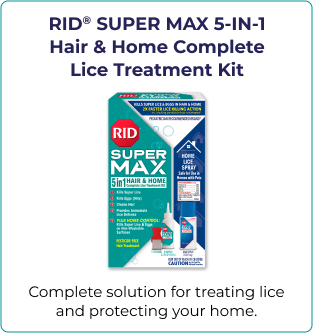Even though millions (yes, 6 to 12 million) of children get lice each year, having them still feels uncomfortable and even embarrassing when children get sent home early from school or camp. Unlearning some lice myths can be comforting to you and your child, and they can help you prepare in case you are unlucky enough to get lice.
Myth #1: Lice are attracted to dirty hair.
Fact: Personal hygiene has nothing to do with getting lice.
The myth that dirty hair causes lice may not only make you or your child feel self-conscious if they get lice. It also prevents people from understanding how lice actually spread from person-to-person. The truth is that anyone who has had close contact with someone who has lice can get them—regardless of their cleanliness or their age.
Myth #2: Lice can fly or jump from head-to-head.
Fact: Lice can’t fly.
They can only crawl through close head-to-head contact or by sharing items that have been in contact with hair.
Myth #3: An itchy scalp means you have lice.
Fact: Just because your child’s scalp is itchy, doesn’t mean they have lice.
While an itchy scalp is a telltale sign of and should be cause for closer inspection, it has many causes—from dandruff to dry skin. If you think that your child has lice, take a look at our step-by-step guide on checking for lice. To start, all you need is a comb and a paper towel.
Myth #4: Lice can spread through pets.
Fact: The types of lice that affect you don’t live on pets, and the types of lice that live on animals can’t live on you.
If you’re worried that your pet has lice, reach out to your veterinarian for more information. RID® is not approved for use on animals.
Myth #5: You need an exterminator to get rid of lice in your home.
Fact: Lice can only survive up to 2 days after being removed from your scalp.
While lice prefer to stay on the human scalp, they can live on personal items and household surfaces for a couple of days . That means lice can still spread to other family members and even people who have recently been treated. While you won’t need an exterminator, take these steps after lice treatment to ensure you’ve gotten rid of lice from your home:
- Soak combs and brushes used before or during lice removal in hot water (for 5–10 minutes)
- Vacuum the floor and furniture
- Machine wash clothing, bed linens, and other items that came into contact with the person who had lice, using hot water followed by the hottest drying cycle for at least 20 minutes
- Seal items that can’t be washed (bedspreads, pillows, stuffed toys, etc.) in a plastic bag for 4 weeks, then carry them outdoors and shake them hard before using them again
- Spray items that can’t be washed or stored, such as mattresses, furniture, or car interiors, with RID® SUPER MAX Home Control Spray. It kills lice, super lice, and nits (lice eggs) and is safe for use in homes with pets
Get lice treatment products that are effective in hair and home with the RID® SUPER MAX 5-in-1 Hair & Home Complete Lice Treatment Kit. It contains pesticide-free shampoo that kills lice 2X faster than the leading pesticide-based treatment** and a home control spray that’s 10X more effective than Nix® Killing Spray.†
If you’re concerned about lice in your hair and home, try RID® SUPER MAX 5-in-1 Hair & Home Complete Lice Treatment Kit or add RID SUPER MAX Home Control Spray (sold separately) as the perfect complement to any of our other lice treatment products.


Browse all RID® lice treatment products near you or online. Learn more about Lice Defense.
**Data on file: RID® SUPER MAX Advanced Shampoo Lice Treatment versus leading pesticide hair treatment (Permethrin 1% Créme Rinse).
†Data on file versus Nix® permethrin 0.25% Lice Killing Spray.
